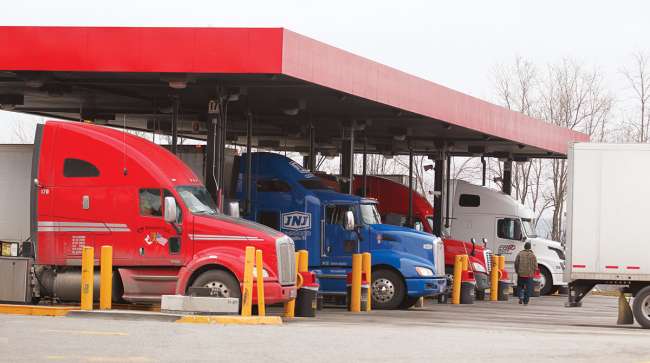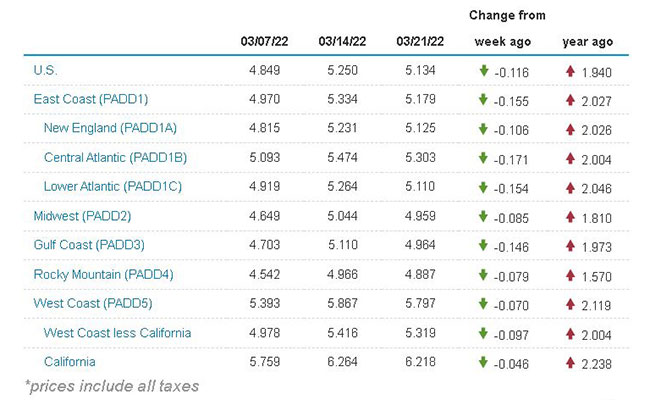Diesel Ends 10-Week Surge, Dropping 11.6¢ to $5.134 a Gallon

[Stay on top of transportation news: Get TTNews in your inbox.]
The national average price of diesel reversed course and shed 11.6 cents to $5.134 a gallon, according to Energy Information Administration data released March 21.
The cost of diesel had risen every week since Jan. 3 by a total of $1.637.
Despite the current decline, a gallon of diesel still costs $1.94 more than it did a year ago.
#TodayInEnergy - U.S. #gasoline and #diesel prices declined slightly the week after their March 14 peak.
Read more: https://t.co/9luky954SE pic.twitter.com/XsMofdX34d — EIA (@EIAgov) March 23, 2022
Gasoline also fell nationally by 7.6 cents to $4.239 a gallon.
EIA reported that the price of diesel fell in all 10 regions in its weekly survey. The Central Atlantic experienced the steepest drop at 17.1 cents to $5.303. California saw the smallest decline at 4.6 cents to $6.218.
“It’s just a lot of volatility, and we’re expecting the potential for continued price spikes,” Phil Flynn, senior energy analyst at The Price Futures Group, told Transport Topics. “Diesel supplies globally look like they’re going to continue to be squeezed for some period to come.”

Flynn
Flynn noted that while fuel costs may stay on an upward trajectory, there will be some price swings.
“Diesel is really the product to watch,” said Tom Kloza, founder of the Oil Price Information Service. “It will infiltrate every nook and cranny of the economy in terms of inflation and surcharges and so forth.”
President Joe Biden signed an executive order banning the import of Russian oil after the nation’s president, Vladimir Putin, ordered an invasion of Ukraine on Feb. 24. The European Union has considered similar steps.
“The EU might put an oil buying ban on Russia, [and that] is raising concerns,” Flynn said. “That’s creating a tight diesel market, and that’s why prices have been up.”
Diesel is really the product to watch. It will infiltrate every nook and cranny of the economy in terms of inflation and surcharges and so forth.
Tom Kloza, founder of the Oil Price Information Service
The Federal Reserve signaling it will raise interest rates also could play a role. Goldman Sachs said March 22 that it expects rates to increase by 50 basis points in May and June.
Flynn also puts some of the blame on the Biden administration.
“It seems like most of their agenda is going to lead to higher prices,” Flynn said. “They’re calling it the Putin price hike. Well, that’s part of it. But some of the tougher regulations on diesel is another issue.”
U.S. On-Highway Diesel Fuel Prices

EIA.gov
But Kloza disagrees.
“It has everything to do with Vladimir Putin, and it has everything to do with we had a cold winter in the Northern Hemisphere and we came out of it with low inventories.”
Like many carriers, Grand Island Express uses fuel surcharges. But when prices rise as rapidly as they have, there’s an impact to the business because there tends to be a lag between the surcharge and diesel costs.

Deen Albert (Grand Island Express)
“We did see a somewhat temporary contraction, but I think it’s important to remember that there will be volatility,” Deen Albert, director of operations at Grand Island Express, told TT. “I’m certainly planning for continually rising diesel prices in the near term.”
PGT Trucking is working closely with its fuel vendors and routing its fleet to fueling locations with the best prices. The company also is working with its customers on fuel surcharges that keep pace with the market.
“We monitor diesel fuel prices very closely and the impact it has on our fuel expense,” PGT Chief Financial Officer Darren Coast told TT. “Different than we saw last year, though, when fuel prices were on a steady increase before stabilizing, the drastic spike in fuel over the last several weeks is mostly due to the uncertainty of supply created by the Russian-Ukraine conflict.”
PGT ranks No. 99 on the Transport Topics Top 100 list of the largest for-hire carriers in North America.

Fox
“Fleets of all sizes are feeling the pain with the rising cost of diesel,” Zach Fox, supervisor of 3PL operations at JZI LogisticSolutions, told TT. “The guys that are going to get hit the hardest are the smaller operations that don’t receive much of a discount at the pump. Ultimately, this is another operational cost that carriers are having to absorb a large portion of.”
DAT Freight & Analytics said in a brief March 22 that rising fuel surcharges kept spot rates elevated in February. That is despite truckload freight volumes falling 12.8%. The national average fuel surcharge for spot van freight was 46 cents per mile.
“Mercer Transportation prides itself on reacting to market conditions and still delivering America’s goods,” Mercer Transportation Co. said in a statement to TT. “We have built strong relationships and aligned ourselves with a quality base of customers with fair fuel surcharge programs to offset some of the dramatic swings.”
Mercer ranks No. 70 on the for-hire TT100.
Want more news? Listen to today's daily briefing below or go here for more info:


